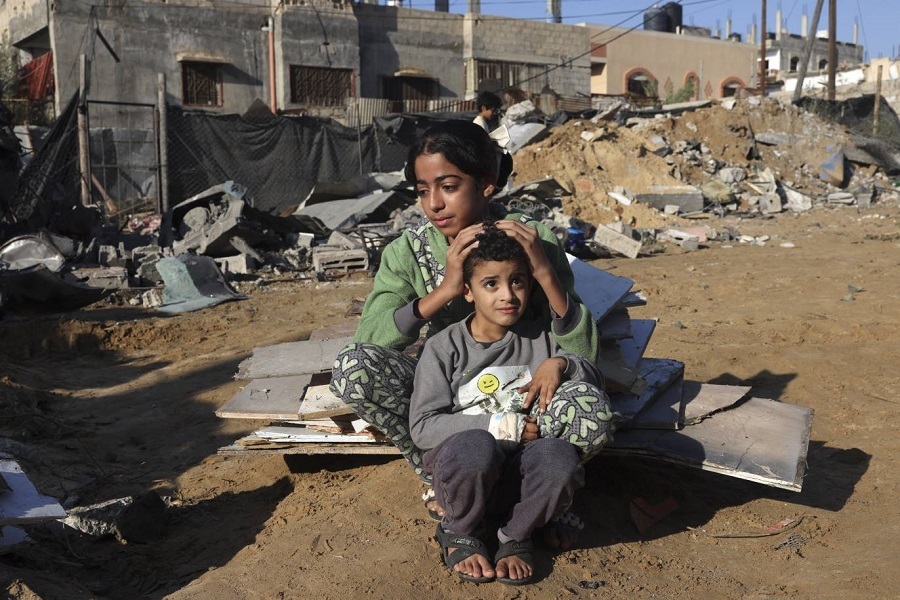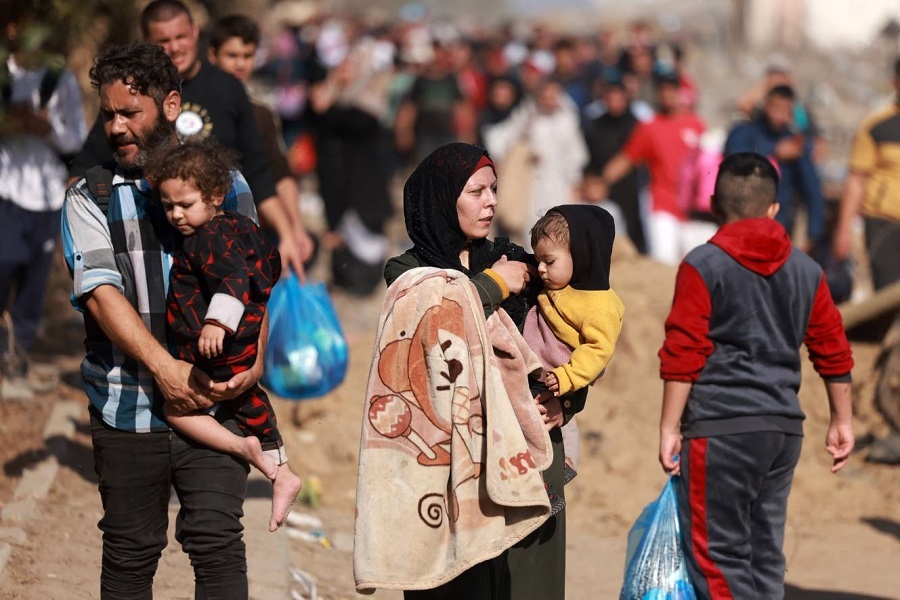‘Children’s Graveyard’: Israeli Gaza Onslaught Takes Horrendous Toll on Children

The gruesome scenes of dead, seriously injured or orphaned children have been coming out of Gaza for more than 40 days now after Israel unleashed a bombardment campaign against the besieged enclave in an indiscriminate and disproportionate military response to Hamas Operation Al-Aqsa Flood.
The Palestinian resistance movement launched the surprise, multi-front operation on October 7 in the wake of decades of violence and persecution against Palestinians.
Nonetheless, the deadliest Israeli assault in decades, is taking a heavy toll on children in the coastal territory.
According to the Geneva-based Euro-Med Human Rights Monitor, Israel has been killing an average of 100 children daily in Gaza since it began its aggressive in the Strip.
On November 10, World Health Organization Director-General Tedros Adhanom Ghebreyesus told the United Nations Security Council that a child is killed on average every 10 minutes in the Gaza Strip.
“Nowhere and no one is safe,” Tedros warned.
Up to the point of filing this article, more than 13,000 people, including over 5,500 children, have been killed in Gaza, according to the Gaza health authorities. The figures are deemed reliable by the United Nations agencies.
The UN humanitarian affairs office also estimates that about 2,700 people, including 1,500 children, are missing and believed buried in the rubble of the buildings which come under Israel’s unrelenting bombing.
WHO reported that there are 27,490 people injured in Gaza, 9,137 of whom are children.
On November 6, the United Nations Secretary-General Antonio Guterres warned that the Gaza Strip was becoming “a graveyard for children.”
“Gaza is becoming a graveyard for children. Hundreds of girls and boys are reportedly being killed or injured every day,” he said.
Newborns lives hanging in the balance
The Israeli regime has laid a complete siege on Gaza since it began the war against the Strip, cutting off water, food and power supplies to the besieged territory.
Power and water crises have shuttered more than half of Gaza’s 35 hospitals which were already struggling under serious shortages of essential supplies
This could lead to a rapidly evolving public health catastrophe, the UN aid agencies warn.
According to the UN Population Fund About 160 women give birth every day in Gaza. It estimates that there are 50,000 pregnant women across the territory of 2.3 million people.
Lives of over 100 premature babies being kept in incubators are now hanging by a thread as Gaza’s hospitals have run out of fuel to power generators that had kept their incubators going.
Khalil al-Dakran, a spokesperson for Al-Aqsa Martyrs Hospital has told Al Jazeera that patients who are hooked up to the machines dependent on fuel are at particular risk.
“If electricity and water outages persist and fuel depletes, patients will be transferred to mass graves if the aggression continues,” al-Dakran warned.
Read More:
On Wednesday, UNICEF Executive Director Catherine Russell, in a statement denounced the “devastating” scenes she witnessed during her visit to Gaza, urging the parties to the conflict to “stop this horror.”
“The parties to the conflict are committing grave violations against children; these include killing, maiming, abductions, attacks on schools and hospitals, and the denial of humanitarian access – all of which UNICEF condemns,” the head of the UN children’s agency said.
“Many children are missing and believed buried under the rubble of collapsed buildings and homes, the tragic result of the use of explosive weapons in populated areas. Meanwhile, newborn babies who require specialized care have died in one of Gaza’s hospitals as power and medical supplies run out, and violence continues with indiscriminate effects.
“In the hospital’s neonatal ward, tiny babies were clinging to life in incubators, as doctors worried how they could keep the machines running without fuel,” she lamented.
Water shortages, starvation and diseases
Gaza’s one million children are also facing drastic food shortages and mounting challenges to access safe drinking water and sanitation as the war is unfolding.
The dire and pressing lack of food and clean water can lead to grave consequences for children, roughly 50 percent of the besieged enclave population.
Gaza’s water system has been seriously impacted or rendered non-operational due to fuel shortages as well as damages to the vital infrastructure by Israel’s incessant, relentless bombings.
According to the UNICEF, the water production capacity is currently a mere 5 percent of its usual daily output.
Aid agencies are concerned that decreased access to clean water and sanitation can kill more civilians than bombs or bullets.
They say that the tainted water, likely rife with bacteria, can lead to an outbreak of cholera or other diarrheal diseases may have an especially widespread impact on Gaza’s young population because they have much less blood volume compared to adults and are going to dehydrate faster than adults.
 Palestinians fleeing Gaza City and other parts of northern Gaza carry children as the walk along a road leading to the southern areas of the enclave on November 18, 2023, amid Israel's onslaught in the Strip. (Photo by AFP)
Palestinians fleeing Gaza City and other parts of northern Gaza carry children as the walk along a road leading to the southern areas of the enclave on November 18, 2023, amid Israel's onslaught in the Strip. (Photo by AFP)
Moreover, as thousands of evacuees from northern Gaza are forced into cramped, crowded areas in the southern half of the territory other illnesses — specifically, respiratory viruses — are beginning to spread.
The WHO has reported at least 22,500 cases of acute respiratory infections and 12,000 cases of diarrhea, which can be deadly in children suffering from dehydration and lack of food.
On Thursday, the World Food Programme (WFP) reported that cases of malnutrition and dehydration “are increasing rapidly and by the day” in Gaza.
Practically the entire population of Gaza now needs food assistance, WFP says.
“People are barely able to have one meal a day, food options are limited to canned food, if it is available, and bread is a rare luxury,” it adds.
“Gaza actually risks sliding into hunger hell without fuel and a rapid surge in food supplies,” said Abeer Atefa, WFP Senior Spokeswoman for the Middle East, speaking from Cairo.
She warned that “with winter fast approaching, and the unsafe and overcrowded shelters, lack of clean water, people are facing the immediate possibility of starvation.”
According to Atefa only 10 percent of necessary food data-x-items have entered the enclave since the start of the war, creating “a massive food gap.”
Read More:
“Some people have actually resorted to consuming raw onions, uncooked eggplant, whatever they can get their hands on,” she said.
Children’s growth and development depend on receiving nutrition and undernutrition prevents them from reaching their physical and cognitive potential and makes them much more vulnerable to disease and death, according to the WHO.
“The footage of children being rescued from beneath the rubble, injured and in distress, while trembling in hospitals as they await treatment, portrays the immense horror these children are enduring. But without humanitarian access, the deaths from attacks could be the tip of the iceberg,” said Adele Khodr, UNICEF Regional Director for the Middle East and North Africa.
“The death toll will increase exponentially if incubators start to fail, if hospitals go dark, if children continue to drink unsafe water and have no access to medicine when they get sick.”
The psychological effects
The children of Palestine, especially Gazan children, have experienced war and trauma for decades due to the continuous Israeli occupation of the territories.
Weeks of bombardment of the Gaza Strip which began in early October has exacerbated the already-critical mental health crisis for Gaza’s children.
Disturbing findings by the international nonprofit Save the Children, published in June 2022, showed that fifteen years of life under blockade has left four out of five children in the Gaza Strip reporting that they live with depression, grief and fear.
It revealed that the mental well-being of children, young people and caregivers has dramatically deteriorated since a similar study in 2018, with the number of children reporting emotional distress increasing to 80 percent from 55 percent.
Read More:
Jason Lee, Save the Children’s Country Director for the occupied Palestinian territory, have recently warned that the toll of conflict and the blockade on children’s mental health is “too great.”
“We are running out of words to raise the alarm in strong enough terms or to articulate the scale of children’s suffering.
“There must be a ceasefire. Without one, the children who aren’t killed will have their last reserves of hope and trust that they will be protected completely destroyed. Every day of violence means more mental and physical scars that will last a lifetime. Without an immediate ceasefire, there’s a very real risk that children’s mental health will be pushed to the point of no return,” Lee said.
By Maryam Qarehgozlou



